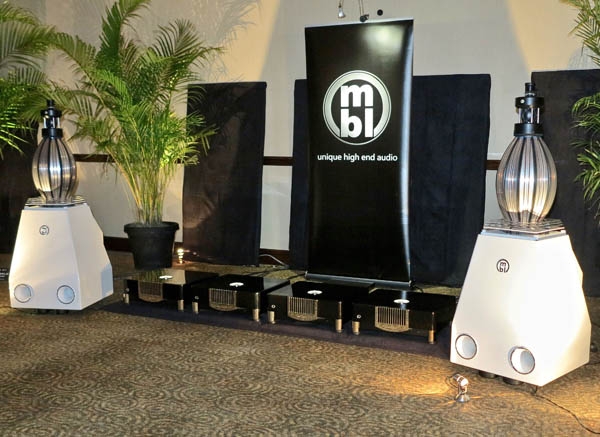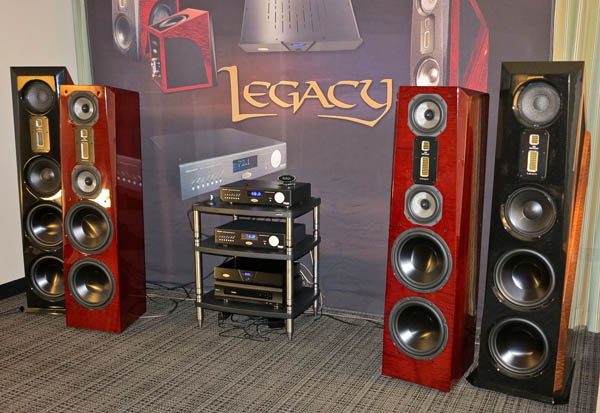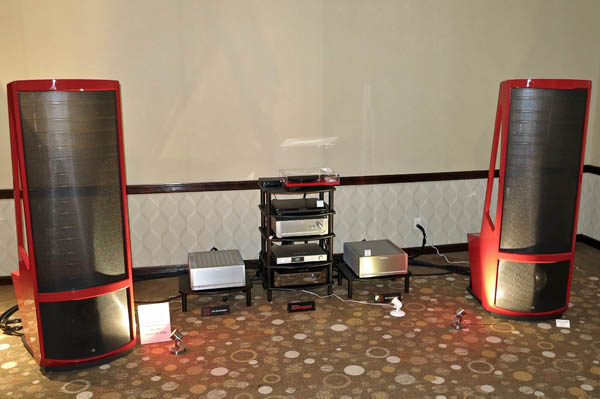| Columns Retired Columns & Blogs |
"Makin' Whoopee!" ......... Dr. John with Rickie Lee Jones :-) .........

It certainly wasn't hard to linger in the mbl room on the second floor. Thanks to Jeremy Bryan's set-up acumen, Nat King Cole's impeccably enunciated "Stardust" and Blue Tofu's "A Battle Between" both sounded warm and spacious, with fast, near-ideal bass. A live-to-two-track recording of the Tara Labs Allstars (David Benoit, Jim Keltner, and Nathan East) playing the Linus and Lucy theme from Peanuts sounded really nice and warm. By the time I got to Jennifer Warnes's "Ballad of the Runaway Horse," however, I began to feel that, as amazing as the sound was, the same warm tinge on everything suggested some top end roll-off. As much as I loved hearing my own 24/96 files of Cecilia Bartoli singing Vivaldi and an ad hoc trio performing Debussy, as well as a superb tape transfer of Joni Mitchell's 2000 recording of "Both Sides Now," I wanted for more neutrality. Mitchell's nicotine-tinged poignancy was a bit too sugar-coated for my taste.
Doing the considerable honors: mbl N31 DAC–CD player ($15,400), mbl 101 E MKII Radialstrahler loudspeaker ($70,500/pair), the West Coast premieres of the mbl N11 stereo preamp ($15,600) and N15 monoblocks ($17,800/each), United Home Audio Ultima4 ops-dc-powered tape deck ($30,000), Wireworld Series 8 Eclipse cabling, and SMT of Sweden room treatment.

The first time I entered the Legacy room on the 4th or 5th floor, three beer-guzzling guys had decided to turn the exhibit into their own public man cave. I later saw one of these guys staggering out of the elevator.
Unable to hear the music over the din, I returned on Day Three, when Bill Dudleston graciously took the time to copy my 24.96 file of the first movement of Andris Nelson's Boston Symphony Orchestra recording of Shostakovich's Symphony 4 to HD. (Note that this DG recording of Symphonies 4 & 11, which nabbed Grammys for Best Engineered Recording and Best Classical Orchestral performance just last week, was lauded in my January 2019 "My Back Pages" Shostakovich Symphony round-up, and is available for streaming in 24/96 MQA on Tidal and 24/96 flac on Qobuz. In September, I heard the BSO and Nelsons perform Symphony 4 in Philharmonie de Paris, and can attest to the recording's sonic truthfulness.)
This was the most successful demo of Legacy loudspeakers and electronics I've experienced in many a show. Although I couldn't hear much depth from large speakers positioned so close to the wall behind them—Duddleston had no choice in the matter—timbres were extremely neutral and spot on. In the Shostakovich, the speakers threw a huge, high soundstage. I'm not sure that all the bass resonance I heard on the BSO's drums was actually on the recording, but it sure made for rousing listening. As for the high, piercing piccolos, the system truthfully captured how they sound in live performance. I also loved how fine and neutral The Wailin' Jennys' live, a cappella rendition of "Bring me a Li'l Water, Sylvy" sounded. When I requested nastier music, I was impressed with the directness of the treble and strength of bass on "Billie Jean" by The Civil Wars. (For those wishing to bend reality just a bit, there's a common theme to these three selections, sort of.)
Heard in the main system were the Legacy Aeris loudspeakers in what sounds like edible natural Sapele Pommele/Black Pearl finish ($21,150/pair as shown) with Wavelest DAC/preamp/crossover/correction unit (additional $3450) and new Legacy Powerbloc4 amplifier ($2950). Because auditioning the second, smaller Legacy system in the other room at real world levels would have required silencing the main system, I left that one for another show.

Martin Logan and Parasound went all out with their bigger system-the one that was playing when I visited their huge double conference room on the 2nd floor, in which two systems faced each other, with lots of space in between. On an exquisite song by soprano Arleen Auger, Branford Marsalis's "Makin' Whoopee," another from Count Basie, and yet another whose name I didn't get, this quite loud, warmth-tinged system did really well with complex timbres and colors, and also had excellent dynamics.
Transparency was lacking, however, which wasn't surprising considering the digital source. Then again, I've attended a number of demos of electrostats, and have rarely if ever heard the vaunted transparency that some people say reproduces voices to perfection. I wish I could say more about the system, but one of the doors to this room was wide open, and there was a crowd of people just outside who seemed determined to shout over whatever music was wafting their way.
Seen and heard were the MartinLogan Neoliths in Rosso Fusso red ($80,000/pair); Parasound JC 5 two-channel power amp, one powering each channel ($5995 each); Parasound JC 2 BP two-channel preamp ($4495); Parasound JC 3 Jr. phono preamp ($1495); Rega P6 turntable with Rega cartridge ($2000); Aurender A10 music server/DAC with 4TB HD ($5495); and AudioQuest Niagara 7000 AC power conditioner and cabling (approx. $75,000).
If I dare say that the $35,000 system at the other end of the room was touted by the room sponsors as "affordable," someone will surely have my head. So I'm not going to say it.

In another two-system face-off room on the 2nd floor, I heard the larger set-up headed by Von Schweikert Ultra 55 loudspeakers ($90,000/pair) and two Von Schweikert V12XS Shockwave subwoofers ($11,500 each). Von Schweikert was wise to stick to speakers smaller than the mammoths they've brought to some shows, which are challenged to produce tight bass in air-walled environments.
Given that the system also included VAC Statement 450iQ monoblocks ($120,000/pair), and VAC Statement phono stage ($80,000) and line stage ($75,000); Esoteric Grandioso P1 transport ($38,000), two Grandioso D1 monoblock DACs ($19,000 each), Grandioso G1 master clock ($26,000), and surprisingly non-grandiose N-01 streamer/renderer/DAC ($20,000); Kronos Pro turntable with Black Beauty tonearm and Ultracap power supply ($51,000) and Airtight Opus 1 cartridge ($16,000), Critical Mass Maxxum rack ($6,250 per component space x 12), and two Critical Mass Maxxum amp stands ($6250 each), I think it's fair to say that the forces behind the room were hoping to make a no-holds-barred impression. In many ways they did.
Without question, the system handled everything thrown at it with aplomb. Nonetheless, after listening to the Sugar Plum Faeries sound very sweet on an LP of the Royal Ballet, and other cuts including the five-string double bass, flamenco guitar, drums, and percussion on "40 Días" from the Renaud Garcia-Fons Trio, I left the room feeling that the system was overly warm and a bit rolled off on top.

Moving back down to earth, as it were, the day ended at the far more affordable five-DAC Mytek table. There I heard, from left to right in the photo, the Mytek Manhattan II DAC ($5995 plus $995 for network card and $1495 for optional phono card), Brooklyn Bridge DAC with WiFi ethernet steaming ($2995), Brooklyn DAC +, which despite the "+" designation, lacks networking capability ($2195), Liberty DAC, which only accepts digital sources ($995), and Brooklyn amp ($2495). In noisy environments, I find it very hard to focus on music played through open-backed headphones such as the Audeze MX-4 model with balanced connections that was attached to the Brooklyn Bridge. Nonetheless, despite some struggle, I really enjoyed a "Red Book" file of Jeff Buckley singing "Be Your Husband." I especially enjoyed a really pleasing and spacious 24/96 track by Marvin Gaye.

"Makin' Whoopee!" ......... Dr. John with Rickie Lee Jones :-) .........

... transparency on voice because they are not full-range electrostatics. If he hasn't yet done so, JVS should have a listen to the Martin-Logan CLX-art speakers.
Try them with the McIntosh C70 and MC2152.

The Parasound stereo amplifiers in bridged mode may not be supplying enough current for the electrostatic panels ........ It is possible that the Parasound JC-1 mono blocks could have done a better job ......... Stereophile recent review of Matin-Logan another model (ESL 15A) shows that they have impedance of 4 Ohms and below :-) .........

Voice is mostly midrange ....... Theoretically, the powered subwoofers should not be a problem :-) .......

... the crossover between the woofer section and the electrostatic panel occurs in the range of 250–400 Hz - at or above the frequency of middle 'C' - so the woofer section is still operating at least two octaves higher than one might typically expect for a subwoofer.

I did not know that ....... That crossover point is somewhat high ....... Most of the audio 'pundits' recommend subwoofer crossover point max 150-160Hz or below :-) ..........

Another problem could have been that, the subwoofer amp(s) may be supplying enough power to their driver(s) while, the bridged stereo amps most likely are not supplying enough power (current) to the electrostatic panels ........ This uneven distribution of power is happening at 250-400Hz crossover, which is in the lower midrange region ....... That would certainly cause problems in midrange region and above that frequency ...... such as lack of transparency, problems reproducing voice, lack of speed, lack of rhythm and pace, sluggish transient response (and whatever other things you can think of) etc. etc .......
Like I mentioned before, if they used the Parasound JC-1 mono blocks or another brand 'muscle' amp(s), which can deliver some good dose of current into low impedance loads, the results might have been different :-) ........
BTW, when I said 'uneven distribution of power', I'm not talking about politics :-) ........

... referring?
The Neolith is a passive speaker, so the JC5 amps were providing all of the amplification.
Also, how do you know that the amps were operating in bridged mode?
It's possible that one channel (of each amp) was driving the woofer section while the other channel was driving the electrostatic panel.
Finally, the JC5 has a peak output current capability of 90A. How much more current would you think might be necessary?

I did not know that the Neoliths are totally passive speakers ........ I thought the subwoofer section was active, self-powered ........ Martin -Logan provides powered subwoofers to some of their lower priced models ........
JVS mentions in his report that each channel was powered by one stereo amp ........ So, I assumed that the amps were operating in bridged mode ........
TAS has reviewed both the Neoliths and Aurender A-10 ......... You can find those reviews on Google search ..........
The specs say the crossover for the subwoofer is variable 60Hz and 250-400Hz .......
I have hard time believing that the subwoofer drivers and the electrostatic panels are not working in uniform fashion with each other, regardless of the crossover point ........
The TAS reviewer said that there was excellent blending of the subwoofer dynamic drivers and the electrostatic panels ......... TAS reviewer did not say that there was anything wrong with transparency and voice reproduction .......
It is surprising that the set-up people who were demo-ing the system did not hear the lack of transparency and problems with voice reproduction ........

I'm also surprised that for a $80,000 loudspeaker, Martin-Logan did not provide powered subwoofer section ........ I'm also surprised that the crossover controls for the subwoofers go as high as 400Hz, especially when considering one subwoofer driver is facing the front, and another subwoofer driver is facing the back :-) .........
It is possible that, there could have been some 'smearing' of the lower midrange, and hence the voice(s), if the crossover was set-up too high at 400Hz, especially since the woofers are facing in the opposite directions at the bottom :-) .........

Electrostatic transducers have one of the best impulse responses ...... hence, low latency, low IMD and great transparency ....... They are also time-coincident in response ........ Read the measurements of the Quad ESL-2912, reviewed in Stereophile ........ Also, read about electrostatic loudspeakers in Wikipedia :-) ...........

LG seems to have gotten good results using Martin-Logan powered subwoofer(s), with the Quad full-range electrostatic speakers ....... Reviewed recently :-) ........

May be Stereophile could review one of the Legacy Audio floor-standers and Wavelet pre-amp/processor? :-) ..........

"Transparency was lacking, however, which wasn't surprising considering the digital source."
WHAT THE HELL?!?!?! :-)))
Only analog gives us transparency? :-))
Man...

The particular digital source. See my full review of the Aurender A10 elsewhere on this site.

Just don't use the poor MQA filter with conventional playback!